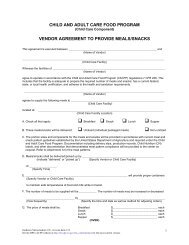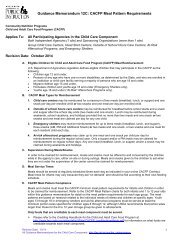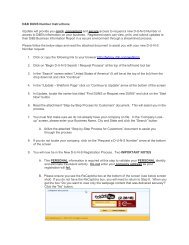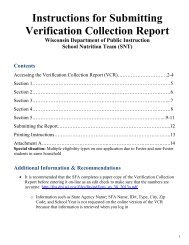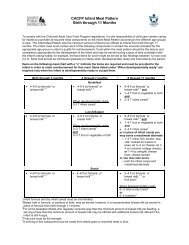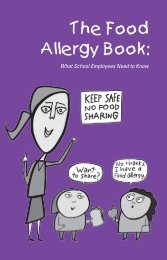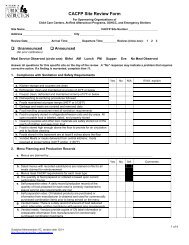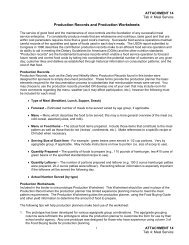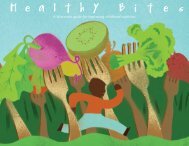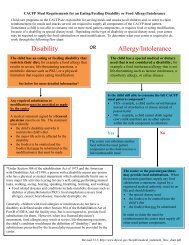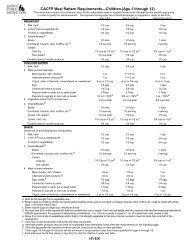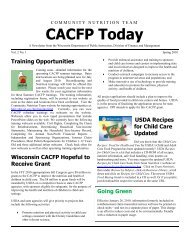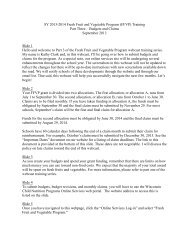sodium.‣ Go light on the salad dressings, sauces, and dips.Build a Healthy Plate with Dry Beans and PeasDry beans and peas are unique foods. They are nutritious, inexpensive, andcreditable as either a vegetable or a meat alternate in the SFSP meal pattern. Theyare great sources of protein, iron, zinc, folate, and fiber. Most children 2 years andolder do not consume enough vegetables, including dry beans and peas. You canhelp by offering beans and peas on your menu. Offering dry beans and peas as partof a meal or snack can: Help children feel full longer and maintain a healthy weight as they grow. Promote proper digestion. Add shape, texture, and flavor to children’s plates.What type of dry beans and peas should I offer?‣ Cooked, canned, or frozen dry beans and peas are all great choices.‣ Mix things up by providing different types of beans and peas each week tohelp children get the nutrition they need, as well as taste new foods.‣ Remember: dry beans and peas may be considered both as a vegetable anda meat alternate; however, they cannot be credited as both a vegetable anda meat alternate in the same meal.How can I reduce sodium and solid fats when serving dry beans and peas?Since dry or frozen beans and peas are naturally low in sodium (salt) and solidfats, prepare and serve beans and peas without adding too much salt or solid fatslike butter, stick margarine, cream sauces, and regular, full-fat cheese. Here’s how:‣ Choose the easiest form: Use canned, precooked beans. They will simplifyrecipes and reduce cooking times. Purchase canned beans labeled “no saltadded” or “low sodium.” If these are not available, rinse and drain thecanned beans to reduce the sodium content.‣ Pour a bag of dry beans into a bowl of water on the kitchen counter. Soakdry beans overnight without adding any salt, and discard the soaking waterand cook the next day.‣ Choose fat-free refried beans, or reduced-sugar and reduced-sodiumversions of baked beans.‣ Use herbs or no-salt spice mixes instead of salt, butter, or stick margarineto season bean dishes. This will lower solid fats, sodium, and calories inthe dishes while adding flavor. Garlic, celery, onion, and carrotscomplement the flavors of dry beans and peas.Meat and Meat Alternates: Build a Healthy Plate with Protein<strong>Child</strong>ren should eat a variety of meat and meat alternates each week. These foodsinclude fish, shellfish, dry beans and peas, nuts, and seeds, as well as lean meats,poultry, and eggs. Most children 2 years and older do not consume enough fish,shellfish, and dry beans and peas. You can help by offering different meat andmeat alternates on your menu. Include a variety of meat and meat alternates atmeals and snacks to: Give children the protein, B vitamins, and minerals (like iron, zinc, andmagnesium) they need to grow, play, and learn.28
Protect children’s hearts, brains, and nervous systems with heart-healthy oilsfrom fish and seafood. Help children feel full for longer with protein.What types of meat and meal alternates should I offer?Providing different choices each day helps children get the nutrition they need andintroduces them to new foods.‣ Fish and seafood (fresh, frozen, or canned) are good choices for mealtime.Try salmon, tuna, trout, and tilapia prepared in different ways: baked,grilled, or in sandwiches or tacos.‣ Poultry, like chicken or turkey, can be served grilled, roasted, or in pastasor burritos.‣ Look for lean cuts of meat, including beef, pork, and lamb. Try roundsteaks and roasts (round eye, top round, bottom round, round tip), top loin,top sirloin, and chuck shoulder and arm roasts. The leanest pork choicesinclude pork loin, tenderloin, or center loin.‣ Choose the leanest ground meats possible (including beef, pork, chicken,and turkey), preferably meats labeled “90% lean” or higher. The higher the% number, the lower the amount of solid fats in the meat.‣ Offer unsalted, chopped, or finely ground nuts and seeds (includingalmonds, mixed nuts, peanuts, walnuts, sunflower seeds), and peanut andsunflower seed butters spread thinly.‣ Prepare and serve eggs in different ways. Try hard-boiled egg slices,scrambled eggs, or deviled eggs (prepared with low-fat mayo or mustard).Make sure the egg whites and yolks are cooked thoroughly to avoidfoodborne illness.‣ Cooked, canned, or frozen dry beans and peas are all great options. Varythe choices for dry beans and peas.‣ Yogurt and cheese can be credited as a meat alternate. Offer yogurt labeledfat-free or low-fat (1%). When selecting cheese, choose low-fat or reducedfatversions.‣ Serve processed soy products, such as meatless “chicken” nuggets or soyburgers that are creditable. To credit soy products as a meat alternate, theymust have a <strong>Child</strong> <strong>Nutrition</strong> (CN) Label or a company-certified productformulation statement. (Use only creditable products; check with yourState agency or sponsoring organization for additional guidance.)‣ Remember: some children coming to your site may be allergic to fish,shellfish, soy, milk, wheat, eggs, nuts, and seeds. Actively supervisechildren when serving these foods.How can I serve a variety of meat and meat alternates low in sodium and solidfats?Be sure to start with lean choices for meat and meat alternates. Use recipes withoutadding too much sodium (salt) or solid fats like butter, stick margarine, creamsauces, gravy, and regular, full-fat cheese. Here’s how:‣ Use herbs or no-salt spice mixes instead of salt, butter, or stick margarineto season dishes. This will lower solid fats, sodium, and calories in thedishes while adding flavor.29
- Page 1 and 2: The Summer Food Service ProgramSumm
- Page 3 and 4: CONTENTSINTRODUCTION ..............
- Page 5 and 6: Using a Food Thermometer ..........
- Page 7: DietaryGuidelines forAmericansThe D
- Page 10 and 11: FOOD COMPONENTS AND FOOD ITEMSSUMME
- Page 12 and 13: Offer VersusServe (OVS)Offer versus
- Page 14: More on FoodComponentsThis section
- Page 17 and 18: For lunch and supper, 8 oz. or 1 cu
- Page 19 and 20: ProductFormulationSchool Foodservic
- Page 21 and 22: Summer Menu PlanningIn this section
- Page 23 and 24: CalculatingServing Sizesand CostsCh
- Page 25 and 26: Sample Cycle MenusThe following is
- Page 27 and 28: Making the Most of Summer MealsBuil
- Page 29: fruits are naturally sweet, it can
- Page 33 and 34: What type of grains should I offer?
- Page 35 and 36: Prepare a stir-fry with a variety o
- Page 37 and 38: SampleRecipesThe following recipes
- Page 39 and 40: 2 ¼ tsp Salt-free chili-lime seaso
- Page 41 and 42: Education and EnrichmentIn this sec
- Page 43 and 44: The Physical EnvironmentIf you are
- Page 45 and 46: PromotingPhysicalActivityWhile phys
- Page 47 and 48: Spotlight on Summer Food Service Pr
- Page 49 and 50: amounts of foods that will meet the
- Page 51 and 52: PART II — NUTRITION SERVICESHire
- Page 53 and 54: Getting Organized: Food Purchasing
- Page 55 and 56: DevelopingFoodSpecificationsWhen pr
- Page 57 and 58: How to Use theFood BuyingGuideUSDA'
- Page 59 and 60: Additional information about calcul
- Page 61 and 62: MenuProductionRecordsThe SFSP regul
- Page 63 and 64: ScoopsThe number of the scoop indic
- Page 65 and 66: Keep Food Fresh: Food StorageIn thi
- Page 67 and 68: Drive Dirt and Germs Out: Food Sani
- Page 69 and 70: Take Precautions: Food SafetyIn thi
- Page 71 and 72: SEPARATESeparate foods that are rea
- Page 73 and 74: For additional information, visitht
- Page 75 and 76: Call the local or State Health Depa
- Page 77 and 78: E. Coli ReportAccording to USDA's F
- Page 79 and 80: Minimum Safe Internal Temperatures
- Page 81 and 82:
Approximate Storage Life in Days of
- Page 83 and 84:
e Will harden at high temperature,
- Page 85 and 86:
Frozen Food Storage (continued)The
- Page 87 and 88:
f Garlitz, Carol J., Boor, K., and
- Page 89 and 90:
Food Safety ChecklistDate__________
- Page 91 and 92:
Food Safety Checklist, continuedFOO
- Page 93 and 94:
Questions and Answers1. I have to h
- Page 95 and 96:
with food safety information, which
- Page 97 and 98:
MyPlateThe U.S. Department of Agric
- Page 99 and 100:
meal. Example: An orange and orange
- Page 101 and 102:
GROUP DMINIMUM SERVING SIZE FOR GRO
- Page 103 and 104:
How to Read Nutrition LabelsNutriti
- Page 105 and 106:
3. Limit these nutrientsIn general,
- Page 107 and 108:
Food Sources of Vitamin A (Continue
- Page 109 and 110:
Food Sources of Vitamin C (Continue
- Page 111 and 112:
Food Sources of Vitamin C (Continue
- Page 113 and 114:
Food Sources of Iron (Continued)Foo
- Page 115 and 116:
Food Sources of CalciumAll foods li
- Page 117 and 118:
Serving Sizes and Yields for Vegeta
- Page 119 and 120:
Serving Sizes and Yields for Fruits
- Page 121 and 122:
e of the Position:Sample Position D
- Page 123 and 124:
Food Service Equipment NeedsEquipme
- Page 125 and 126:
Quaternary ammonium compounds (Quat
- Page 127 and 128:
Sanitize Smallware in a Mechanical
- Page 129 and 130:
CAUTION:All equipment should be kep
- Page 131 and 132:
Food Inventory Record InstructionsT
- Page 133 and 134:
Date Marking Ready-to-Eat, Potentia
- Page 135 and 136:
DAILY TEMPERATURE FORM - INTERNAL F
- Page 137 and 138:
RESOURCE SECTIONInformation Resourc
- Page 139 and 140:
Nutrition.govNIFANCEMCHAdditional o
- Page 141 and 142:
Serving It Safe: A Manager’s Tool



